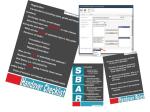


Theme
Postgraduate Education
INSTITUTION
Leighton Hospital, Crewe, UK
Effective clinical handover is essential at all levels of patient care. Change to shift-work patterns has placed a greater emphasis on the continuity of clinical information. It is a key priority established by the World Health Organisation and Royal College of Physicians (RCP), but handover skills are rarely taught to undergraduates or postgraduates.
All handovers are easily auditable with a named, accountable individual allocated to each task.
Handover task completion rates improved from 30.4% before intervention to 90.1% (relative benefit 2.96, p<0.0001)
Significant improvement in trainee confidence with handover (p=0.0005), task prioritisation (p=0.0019) and time management (p=0.0229)
Trainee attitudes towards handover safety have improved significantly (p=0.0054).
Improved trainee confidence was reflected in increased capacity to manage their out-of-hours’ workload.
A structured handover supported by a formalised training program and assisted by electronic handover is managing, tracking and completing clinical tasks in an appropriate timescale and improves patient safety.
With thanks to:
Better Training, Better Care and Health Education England
Kay Brown and Yvette Cranney
Ascribe
At MCHT we introduced a structured handover, supported by validated training on task prioritisation, time management and effective handover with all trainees within the general medicine department.
We simultaneously implemented an electronic handover system (Ascribe, UK) which captures all out of hours tasks and assists in allocating, tracking, and documenting completion of all tasks.
We summarised task completion rates documented on the e-system. We assessed trainee attitudes to handover safety using the Safety Climate Questionnaire.
Formal, grade-specific handover training supplemented by e-assisted handover in a structured process has a positive impact on the rates of handover task completion. This reduces the risk patient deterioration being missed or important results not acted on.
WHO collaborating centre for patient safety solutions. Communication during patient hand-overs. Patient safety solutions. 2007;1(3).
Gordon M, Findley R. Educational interventions to improve handover in health care: a systematic review. Medical Education. 2011; 45(11):1081-9
Safe handover: safe patients- Guidance on clinical handover for clinicians and managers. British Medical Associated Junior Doctors committee (in collaboration with the National Patient Safety Agency). 2004.
Arora VM, Johnson JK, Meltzer DO, Humphrey HJ. A theoretical framework and competency-based approach to improving hand-offs. Quality and safety in health care. 2008;17:11-14
Royal College of Physicians. Acute care toolkit 1: Handover. 2011.
 Send Email
Send Email